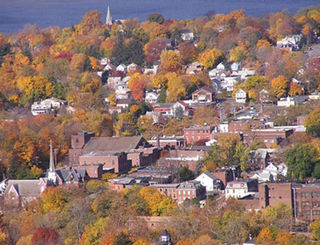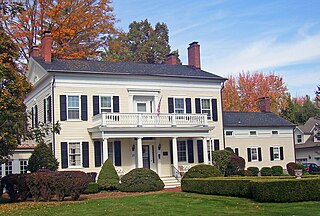
Dutchess County is a county in the U.S. state of New York. As of the 2020 census, the population was 295,911. The county seat is the city of Poughkeepsie. The county was created in 1683, one of New York's first twelve counties, and later organized in 1713. It is located in the Mid-Hudson Region of the Hudson Valley, north of New York City.

Beacon is a city located in Dutchess County, New York, United States. The 2010 census placed the city total population at 15,541. Beacon is part of the Poughkeepsie–Newburgh–Middletown, New York Metropolitan Statistical Area as well as the larger New York–Newark–Bridgeport, New York–New Jersey–Connecticut–Pennsylvania Combined Statistical Area.

Fishkill is a town in the southwestern part of Dutchess County, New York, United States. It lies approximately 60 miles (97 km) north of New York City. The population was 22,107 at the 2010 census. Fishkill surrounds the city of Beacon, and contains a village, which is also named Fishkill.

Beacon Mountain, locally Mount Beacon, is the highest peak of Hudson Highlands, located south of City of Beacon, New York, in the Town of Fishkill. Its two summits rise above the Hudson River behind the city and can easily be seen from Newburgh across the river and many other places in the region. The more accessible northern peak, at 1,516 feet (462 m) above sea level, has a complex of radio antennas on its summit; the 1,595 feet (486 m) southern summit has a fire lookout tower, which was built in 1931.

Fishkill Creek is a tributary of the Hudson River in Dutchess County, New York, United States. At 33.5 miles (53.9 km) it is the second longest stream in the county, after Wappinger Creek. It rises in the town of Union Vale and flows generally southwest to a small estuary on the Hudson just south of Beacon. Part of its 193-square-mile (500 km2) watershed is in Putnam County to the south. Sprout Creek, the county's third-longest creek, is its most significant tributary. Whaley and Sylvan lakes and Beacon Reservoir, its largest, deepest and highest lakes, are among the bodies of water within the watershed.

The Madam Brett Homestead is an early 18th-century home located in the city of Beacon, New York, United States. It is the oldest standing building in its part of Dutchess County and has been listed in the National Register of Historic Places since 1976. It is also listed on the NYS Independence Trail.

Historic Huguenot Street is located in New Paltz, New York, approximately 90 miles (140 km) north of New York City. The seven stone houses and several accompanying structures in the 10-acre National Landmark Historic District were likely built in the early 18th century by Huguenot settlers fleeing discrimination and religious persecution in France and what's now southern Belgium. After negotiating with the Esopus Indians, this small group of Huguenots settled on a flat rise on the banks of the Wallkill River in 1678. The settlers named the site in honor of Die Pfalz, the region of present-day Germany that had provided them temporary refuge before they came to America. Recent archaeological finds indicate that the immediate area settled by the Huguenots was occupied by Native Americans prior to European contact. The site is one of the oldest continuously inhabited settlements in the United States.

The U.S. Post Office in Beacon, New York, is located on Main Street. It serves the ZIP Code 12508, covering the entire city of Beacon and some of the neighboring areas of the Town of Fishkill. It is a stone structure in the Dutch Colonial Revival architectural style built in the mid-1930s. In 1988 it was listed on the National Register of Historic Places along with many other older post offices in the state.

The Reformed Church of Beacon, originally the Reformed Dutch Church of Fishkill Landing, is a historic and architecturally-significant church in Beacon, New York. The congregation, who no longer occupies the building, claims it is the oldest church in Beacon. It is located on NY 9D about 0.5 miles (1 km) south of Beacon's municipal complex and downtown area and overlooks the Hudson River from a bluff.

Cromwell Manor, also known as the David Cromwell House and Joseph Sutherland House, is located on Angola Road in Cornwall, New York, United States, just south of its intersection with US 9W. It consists of four properties, two of which are of note: the 1820 manor house, built in a Greek Revival style and added onto in 1840 and a 1779 cottage known as The Chimneys, the original home on the site.

Stony Kill Farm is located on NY 9D in the Town of Fishkill, New York, United States. It is a 1,000+ acre (3 km2) working farm owned and operated by the state Department of Environmental Conservation (DEC) as an environmental education center.

The Andries DuBois House is located on Wallkill Avenue in the hamlet of Wallkill, New York, USA. It is the oldest house in the hamlet, reflecting several different eras of architecture and regional history, and has been a Registered Historic Place since 1998.

Dutchess Manor is a restaurant located along NY 9D in the Town of Fishkill, New York, United States, between the city of Beacon and Breakneck Ridge. It is one of the most distinctive Hudson Valley buildings in the Second Empire architectural style, and was added to the National Register of Historic Places in 1982.

Woodlawn Farm, sometimes known as the Wood Homestead, is located on Mount Orange Road, a short distance north of Slate Hill, New York, United States. It is centered by a three-section farmhouse whose materials date to the mid-18th century, making it one of the oldest buildings in the Town of Wawayanda. In 2008 it was listed on the National Register of Historic Places.

The Scribner House is located on Roe Avenue in Cornwall, New York, United States. It was built in 1910 as the main house for the summer estate of New York City publishing executive Charles Scribner II, one of Charles Scribner's Sons.
The Hudson Highlands Multiple Resource Area is a Multiple Property Submission study supporting multiple listings in 1982 to the United States National Register of Historic Places. It originally included 58 properties spread over the counties of Dutchess, Putnam, Westchester, Orange and Rockland.

The Cornelius Carman House is located along River Road South in Chelsea, New York, United States. It is a wooden house built in the 1830s, overlooking the Hudson River, for Carman, operator of a local shipyard and inventor of a moveable centerboard.

The Storm–Adriance–Brinckerhoff House is located on Beekman Road in East Fishkill, New York, United States. It is a wooden building in three parts, the oldest of which dates to the mid-18th century.

Bykenhulle, originally known as Ivy Hall, is a historic house located on Bykenhulle Road near the hamlet of Hopewell Junction, New York, United States, in the Town of East Fishkill. It is a wooden house in the Greek Revival architectural style.

Oak Hill is a historic estate located at Linlithgo in Columbia County, New York.















